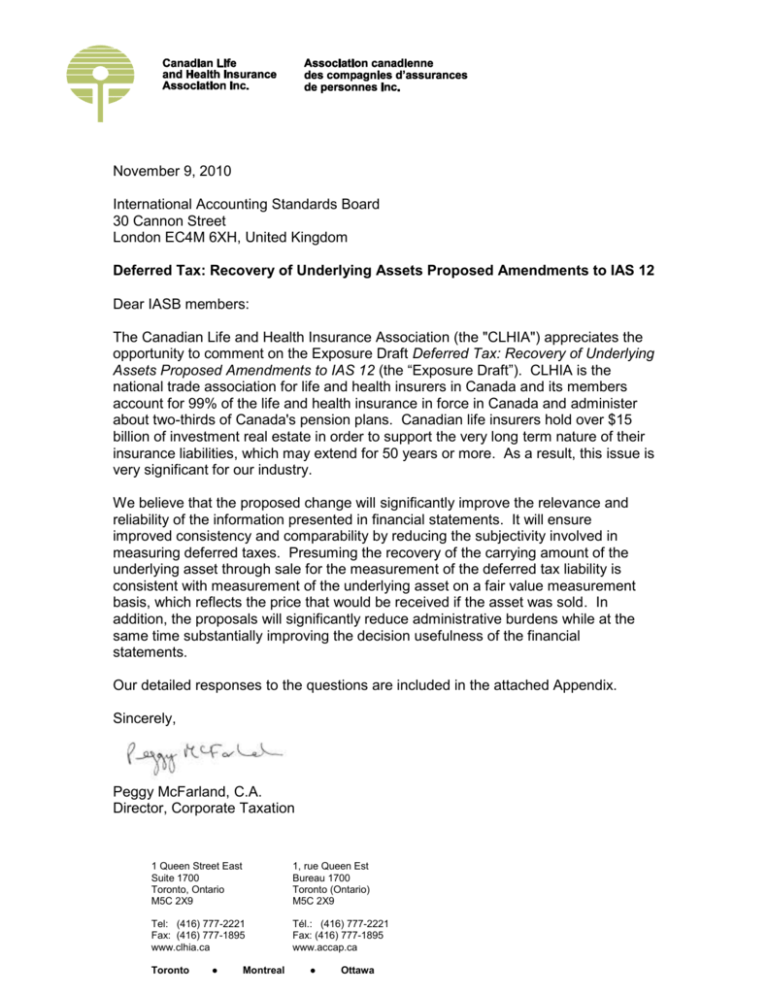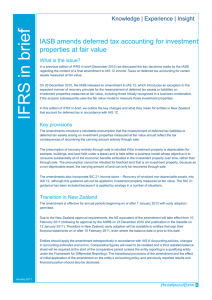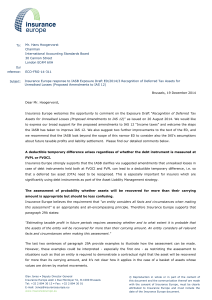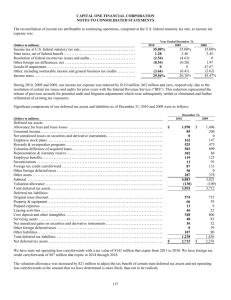CLHIA Letterhead
advertisement

November 9, 2010 International Accounting Standards Board 30 Cannon Street London EC4M 6XH, United Kingdom Deferred Tax: Recovery of Underlying Assets Proposed Amendments to IAS 12 Dear IASB members: The Canadian Life and Health Insurance Association (the "CLHIA") appreciates the opportunity to comment on the Exposure Draft Deferred Tax: Recovery of Underlying Assets Proposed Amendments to IAS 12 (the “Exposure Draft”). CLHIA is the national trade association for life and health insurers in Canada and its members account for 99% of the life and health insurance in force in Canada and administer about two-thirds of Canada's pension plans. Canadian life insurers hold over $15 billion of investment real estate in order to support the very long term nature of their insurance liabilities, which may extend for 50 years or more. As a result, this issue is very significant for our industry. We believe that the proposed change will significantly improve the relevance and reliability of the information presented in financial statements. It will ensure improved consistency and comparability by reducing the subjectivity involved in measuring deferred taxes. Presuming the recovery of the carrying amount of the underlying asset through sale for the measurement of the deferred tax liability is consistent with measurement of the underlying asset on a fair value measurement basis, which reflects the price that would be received if the asset was sold. In addition, the proposals will significantly reduce administrative burdens while at the same time substantially improving the decision usefulness of the financial statements. Our detailed responses to the questions are included in the attached Appendix. Sincerely, Peggy McFarland, C.A. Director, Corporate Taxation 1 Queen Street East Suite 1700 Toronto, Ontario M5C 2X9 1, rue Queen Est Bureau 1700 Toronto (Ontario) M5C 2X9 Tel: (416) 777-2221 Fax: (416) 777-1895 www.clhia.ca Tél.: (416) 777-2221 Fax: (416) 777-1895 www.accap.ca Toronto ● Montreal ● Ottawa APPENDIX - Responses to Exposure Draft Questions Question 1 – Exception to the measurement principle Question: The Board proposes an exception to the principle in IAS 12 that the measurement of deferred tax liabilities and deferred tax assets should reflect the tax consequences that would follow from the manner in which the entity expects to recover or settle the carrying amount of its assets and liabilities. The proposed exception would apply when specified underlying assets are remeasured or revalued at fair value. Do you agree that this exception should apply when the specified underlying assets are remeasured or revalued at fair value? Why or why not? Response: We agree that this exception should apply given that in applying the expectation approach under IAS 12, in many cases, it is difficult and subjective to determine the expected manner of recovery when the specified underlying assets are remeasured or revalued at fair value. The situation of most concern to the Canadian life insurance industry is the treatment of investment properties, as such properties may be held to earn rental income as well as capital appreciation at some time in the future. The Canadian life insurance industry strongly believes that the only practical and realistic approach to the measurement of deferred taxes with respect to investment properties is to assume that the value of these assets will be recovered through sale. The industry has consistently applied this approach to its investment properties under current estimates of the impact of adopting IFRS on opening retained earnings. However, clarification that this method is appropriate under IFRS and further guidance in this area are urgently needed. In situations where there are no immediate plans for disposal of the investment property, it is very difficult and subjective to estimate how much of the carrying amount of the investment property will be recovered by cash flows from rental income and how much of it will be recovered by cash flows from selling the asset. In particular, it is difficult to estimate the residual value at the end of the period. IAS 12 also requires the bifurcation of the fair value into land and building components. This imposes another level of subjectivity in the estimation process required by existing IAS 12. While this exercise would be challenging enough to administer for a limited number of properties, it would be even more difficult as the quantum of properties subject to the estimation process increases; some Canadian life insurance companies have 2 hundreds of investment properties. Given that the industry holds over $15 billion of real estate investments to support the long-term nature of its policy liabilities, which may extend for 50 years or more, this is an extremely significant issue for our industry. The exposure draft provides a practical approach that avoids subjective estimates of an entity’s expected manner of recovery of its assets and liabilities while reducing the related administrative burden. We strongly support the exception proposed in the exposure draft when the specified underlying assets are remeasured or revalued at fair value. Question 2 – Scope of the exception Question: The Board identified that the expected manner of recovery of some underlying assets that are remeasured or revalued at fair value may be difficult and subjective to determine when deferred tax liabilities or deferred tax assets arise from: (a) investment property that is measured using the fair value model in IAS 40; (b) property, plant and equipment or intangible assets measured using the revaluation model in IAS 16 or IAS 38; (c) investment property, property, plant and equipment or intangible assets initially measured at fair value in a business combination if the entity uses the fair value or revaluation model when subsequently measuring the underlying asset; and (d) other underlying assets or liabilities that are measured at fair value or on a revaluation basis. The Board proposes that the scope of the exception should include the underlying assets described in (a), (b) and (c), but not those assets or liabilities described in (d). Do you agree with the underlying assets included within the scope of the proposed exception? Why or why not? If not, what changes to the scope do you propose and why? Response to Question 2: We agree that the scope as outlined in the exposure draft is appropriate. As discussed above, the Canadian life insurance industry’s primary concern is ensuring that investment property that is measured using the fair value model in IAS 40 is included in the scope of the exception. While we are in support of the scope of the exception including the underlying assets described in (a), 3 (b) and (c), we would also agree with limiting the exception to only investment properties using the fair value model in IAS 40 described in (a) above. We support the scope adopted in the exposure draft. Question 3 – Measurement basis used in the exception Question: The Board proposes that, when the exception applies, deferred tax liabilities and deferred tax assets should be measured by applying a rebuttable presumption that the carrying amount of the underlying asset will be recovered entirely through sale. This presumption would be rebutted only when an entity has clear evidence that it will consume the asset’s economic benefits throughout its economic life. Do you agree with the rebuttable presumption that the carrying amount of the underlying asset will be recovered entirely by sale when the exception applies? Why or why not? If not, what measurement basis do you propose and why? Response: We agree with the rebuttable presumption that the carrying amount of the underlying asset will be recovered entirely by sale when the exception applies for the following reasons: presuming the recovery of the carrying amount of the underlying asset through sale for the measurement of the deferred tax liability is consistent with measurement of the underlying asset on a fair value measurement basis that reflects the price that would be received if the asset was sold the exception provides the least subjective manner of measuring deferred taxes, providing users of the financial statements with consistent and comparable financial information. We agree that in certain circumstances, when there is clear evidence that an entity will consume the asset’s economic benefit throughout its economic life, it is not appropriate to assume a recovery of the asset through sale. By making the presumption rebuttable, in such cases, entities may still assume recovery through use when it is more appropriate. We would further point out that the expectation approach under IAS 12 also may not reflect reality and could actually undermine the relevance and reliability of financial statements. In the Canadian tax regime, capital gains are effectively taxed at only 50% of the tax rate applied to business income. 4 Thus, establishing a deferred tax liability assuming use instead of sale could result in a materially higher deferred tax liability that would be realized and brought into income if and when the asset is sold. Such an income inclusion may be material. We support the adoption of the measurement basis as outlined in the exposure draft. Question 4 – Transition Question: The Board proposes that the amendments should apply retrospectively. This requirement includes retrospective restatement of all deferred tax liabilities or deferred tax assets within the scope of the proposed amendments, including those that were initially recognised in a business combination. Do you agree with the retrospective application of the proposed amendments to IAS 12 to all deferred tax liabilities or deferred tax assets, including those that were recognised in a business combination? Why or why not? If not, what transition method do you propose and why? Response: We agree with retrospective application of the proposed amendments to IAS 12 to all deferred tax liabilities or deferred tax assets on the basis that it would result in consistent and comparable financial information and would not be unduly burdensome for entities to apply this retrospectively. We also support retrospective application of the exposure draft to business combinations. We also believe that a timely issuance of the amendment may, in certain circumstances, significantly reduce the accounting efforts with respect to business combinations occurring before the amendment becomes effective, as the application of the proposed amendment will reduce the need for adjustments to either the purchase price allocation or the opening retained earnings during the post-acquisition period. Question 5 – Other comments Response: The issuing date and the effective date of this amendment are of critical importance for countries such as Canada, Brazil, India and South Korea which are adopting IFRS effective 2011. In particular, the ability to early adopt is critical. 5 Companies will be required to disclose the opening transition adjustment as at January 1, 2010 in their 2010 financial statements. Without clarity by the end of December 2010 regarding the IASB's decision on the exposure draft, companies may be in a situation where they may be required to prepare the transition adjustment under existing IAS 12 to be positioned to meet their year-end disclosure deadline, regardless of the final decision. This exercise will be extremely onerous as it involves a number of disciplines, including actuarial, accounting and tax, and it will consume a great deal of time and effort during year-end when resources are stretched to the limit. The Canadian life insurance industry’s strong preference is to avoid this unnecessary exercise. We would like to impress upon the Board the need for clarity, i.e. an official statement or announcement, preferably in early to mid December confirming whether the proposed amendment to the standard will be issued and, if so, whether there will be an early adoption provision for 2010 or 2011. Without timely notice by the end of 2010 of the IASB's approval of the exposure draft recommendations, Canadian companies may be required to prepare the transitional adjustment under the existing IAS 12 guidance which would result in: significant undue work effort for little or no ultimate benefit reduced reliability and comparability of the financial statements due to increased subjectivity. Paragraph 17 indicates that early application will be permitted. If the effective date is after 2011, early application will be critical for the Canadian life insurance industry; otherwise companies would be required to prepare their transitional adjustment under existing IAS 12 and may face the negative consequences noted above. Paragraph BC31 indicates that the Board normally sets an effective date of between six and eighteen months after issuing amendments. If the effective date is after 2011, Canadian life insurers will require regulatory approval to early adopt this amendment. (Canada's Office of the Superintendent of Financial Institutions has indicated that Canadian financial institutions will require their approval to early adopt any changes to IFRS standards.) While early indications are that the regulator will approve such a request, there is the possibility that it could be denied, in which case companies may be forced to have a “double conversion” – first to transition under existing IAS 12 for 2010 and 2011 and then to transition in 2012 or beyond to the amended standard. 6 In paragraph BC29, the Board expressed its view that the proposed change should not be unduly burdensome for entities to apply. In paragraph BC 33, the Board also expresses its intention to finalize any amendments resulting from this exposure draft as soon as possible. In the same paragraph, the Board acknowledges that the amendments address a problem that exists in practice and needs to be solved as soon as possible and that the amendments are straightforward. We are in full agreement with the Board on this matter. Given the consequences that the Canadian life insurance industry will face if this amendment does not proceed quickly, we request that the effective date be set at the earliest date possible. We recommend the Board move forward with this amendment as quickly as possible. Ideally, an issuing date before January 1, 2011, with permission for early adoption, would alleviate any undue compliance burdens and regulatory issues. In the event the IASB decides to issue the proposed amendment to the standard but the amendment will not be issued before January 1, 2011, we request that the IASB formally communicate by that date that the amendment will be issued no later than March 1, 2011, with permission for early adoption. 7






